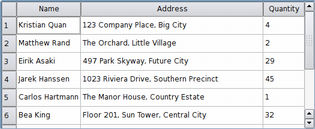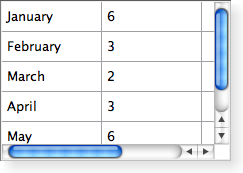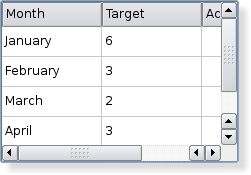QTableView ClassThe QTableView class provides a default model/view implementation of a table view. More... #include <QTableView>Inherits: QAbstractItemView. Inherited by: QTableWidget. Public Types
Properties
Public Functions
Reimplemented Public Functions
Public Slots
Signals
Protected Types
Protected Functions
Reimplemented Protected Functions
Protected Slots
Additional Inherited MembersDetailed DescriptionThe QTableView class provides a default model/view implementation of a table view. A QTableView implements a table view that displays items from a model. This class is used to provide standard tables that were previously provided by the QTable class, but using the more flexible approach provided by Qt's model/view architecture. The QTableView class is one of the Model/View Classes and is part of Qt's model/view framework. QTableView implements the interfaces defined by the QAbstractItemView class to allow it to display data provided by models derived from the QAbstractItemModel class. NavigationYou can navigate the cells in the table by clicking on a cell with the mouse, or by using the arrow keys. Because QTableView enables tabKeyNavigation by default, you can also hit Tab and Backtab to move from cell to cell. Visual AppearanceThe table has a vertical header that can be obtained using the verticalHeader() function, and a horizontal header that is available through the horizontalHeader() function. The height of each row in the table can be found by using rowHeight(); similarly, the width of columns can be found using columnWidth(). Since both of these are plain widgets, you can hide either of them using their hide() functions. Rows and columns can be hidden and shown with hideRow(), hideColumn(), showRow(), and showColumn(). They can be selected with selectRow() and selectColumn(). The table will show a grid depending on the showGrid property. The items shown in a table view, like those in the other item views, are rendered and edited using standard delegates. However, for some tasks it is sometimes useful to be able to insert widgets in a table instead. Widgets are set for particular indexes with the setIndexWidget() function, and later retrieved with indexWidget().
Coordinate SystemsFor some specialized forms of tables it is useful to be able to convert between row and column indexes and widget coordinates. The rowAt() function provides the y-coordinate within the view of the specified row; the row index can be used to obtain a corresponding y-coordinate with rowViewportPosition(). The columnAt() and columnViewportPosition() functions provide the equivalent conversion operations between x-coordinates and column indexes. StylesQTableView is styled appropriately for each platform. The following images show how it looks on three different platforms. Go to the Qt Widget Gallery to see its appearance in other styles.
See also QTableWidget, View Classes, QAbstractItemModel, QAbstractItemView, Chart Example, Pixelator Example, and Table Model Example. Property Documentation
|
| bool | isCornerButtonEnabled() const |
| void | setCornerButtonEnabled(bool enable) |
gridStyle : Qt::PenStyle
This property holds the pen style used to draw the grid.
This property holds the style used when drawing the grid (see showGrid).
Access functions:
| Qt::PenStyle | gridStyle() const |
| void | setGridStyle(Qt::PenStyle style) |
showGrid : bool
This property holds whether the grid is shown.
If this property is true a grid is drawn for the table; if the property is false, no grid is drawn. The default value is true.
Access functions:
| bool | showGrid() const |
| void | setShowGrid(bool show) |
sortingEnabled : bool
This property holds whether sorting is enabled.
If this property is true, sorting is enabled for the table. If this property is false, sorting is not enabled. The default value is false.
Note: . Setting the property to true with setSortingEnabled() immediately triggers a call to sortByColumn() with the current sort section and order.
This property was introduced in Qt 4.2.
Access functions:
| bool | isSortingEnabled() const |
| void | setSortingEnabled(bool enable) |
See also sortByColumn().
wordWrap : bool
This property holds the item text word-wrapping policy.
If this property is true then the item text is wrapped where necessary at word-breaks; otherwise it is not wrapped at all. This property is true by default.
Note that even of wrapping is enabled, the cell will not be expanded to fit all text. Ellipsis will be inserted according to the current textElideMode.
This property was introduced in Qt 4.3.
Access functions:
| bool | wordWrap() const |
| void | setWordWrap(bool on) |
Member Function Documentation
QTableView::QTableView(QWidget * parent = 0)
Constructs a table view with a parent to represent the data.
See also QAbstractItemModel.
QTableView::~QTableView()
Destroys the table view.
void QTableView::clearSpans()
Removes all row and column spans in the table view.
This function was introduced in Qt 4.4.
See also setSpan().
int QTableView::columnAt(int x) const
Returns the column in which the given x-coordinate, x, in contents coordinates is located.
Note: This function returns -1 if the given coordinate is not valid (has no column).
See also rowAt().
void QTableView::columnCountChanged(int oldCount, int newCount) [protected slot]
This slot is called whenever columns are added or deleted. The previous number of columns is specified by oldCount, and the new number of columns is specified by newCount.
void QTableView::columnMoved(int column, int oldIndex, int newIndex) [protected slot]
This slot is called to change the index of the given column in the table view. The old index is specified by oldIndex, and the new index by newIndex.
See also rowMoved().
void QTableView::columnResized(int column, int oldWidth, int newWidth) [protected slot]
This slot is called to change the width of the given column. The old width is specified by oldWidth, and the new width by newWidth.
See also rowResized().
int QTableView::columnSpan(int row, int column) const
Returns the column span of the table element at (row, column). The default is 1.
This function was introduced in Qt 4.2.
See also setSpan() and rowSpan().
int QTableView::columnViewportPosition(int column) const
Returns the x-coordinate in contents coordinates of the given column.
int QTableView::columnWidth(int column) const
Returns the width of the given column.
See also setColumnWidth(), resizeColumnToContents(), and rowHeight().
void QTableView::currentChanged(const QModelIndex & current, const QModelIndex & previous) [virtual protected]
Reimplemented from QAbstractItemView::currentChanged().
void QTableView::hideColumn(int column) [slot]
Hide the given column.
See also showColumn() and hideRow().
void QTableView::hideRow(int row) [slot]
Hide the given row.
See also showRow() and hideColumn().
QHeaderView * QTableView::horizontalHeader() const
Returns the table view's horizontal header.
See also setHorizontalHeader(), verticalHeader(), and QAbstractItemModel::headerData().
int QTableView::horizontalOffset() const [virtual protected]
Reimplemented from QAbstractItemView::horizontalOffset().
Returns the horizontal offset of the items in the table view.
Note that the table view uses the horizontal header section positions to determine the positions of columns in the view.
See also verticalOffset().
QModelIndex QTableView::indexAt(const QPoint & pos) const [virtual]
Reimplemented from QAbstractItemView::indexAt().
Returns the index position of the model item corresponding to the table item at position pos in contents coordinates.
Returns true if the given column is hidden; otherwise returns false.
See also isRowHidden().
Reimplemented from QAbstractItemView::isIndexHidden().
Returns true if the given row is hidden; otherwise returns false.
See also isColumnHidden().
QModelIndex QTableView::moveCursor(CursorAction cursorAction, Qt::KeyboardModifiers modifiers) [virtual protected]
Reimplemented from QAbstractItemView::moveCursor().
Moves the cursor in accordance with the given cursorAction, using the information provided by the modifiers.
See also QAbstractItemView::CursorAction.
void QTableView::paintEvent(QPaintEvent * event) [virtual protected]
Reimplemented from QWidget::paintEvent().
Paints the table on receipt of the given paint event event.
void QTableView::resizeColumnToContents(int column) [slot]
Resizes the given column based on the size hints of the delegate used to render each item in the column.
Note: Only visible columns will be resized. Reimplement sizeHintForColumn() to resize hidden columns as well.
void QTableView::resizeColumnsToContents() [slot]
Resizes all columns based on the size hints of the delegate used to render each item in the columns.
void QTableView::resizeRowToContents(int row) [slot]
Resizes the given row based on the size hints of the delegate used to render each item in the row.
void QTableView::resizeRowsToContents() [slot]
Resizes all rows based on the size hints of the delegate used to render each item in the rows.
int QTableView::rowAt(int y) const
Returns the row in which the given y-coordinate, y, in contents coordinates is located.
Note: This function returns -1 if the given coordinate is not valid (has no row).
See also columnAt().
void QTableView::rowCountChanged(int oldCount, int newCount) [protected slot]
This slot is called whenever rows are added or deleted. The previous number of rows is specified by oldCount, and the new number of rows is specified by newCount.
int QTableView::rowHeight(int row) const
Returns the height of the given row.
See also setRowHeight(), resizeRowToContents(), and columnWidth().
void QTableView::rowMoved(int row, int oldIndex, int newIndex) [protected slot]
This slot is called to change the index of the given row in the table view. The old index is specified by oldIndex, and the new index by newIndex.
See also columnMoved().
void QTableView::rowResized(int row, int oldHeight, int newHeight) [protected slot]
This slot is called to change the height of the given row. The old height is specified by oldHeight, and the new height by newHeight.
See also columnResized().
int QTableView::rowSpan(int row, int column) const
Returns the row span of the table element at (row, column). The default is 1.
This function was introduced in Qt 4.2.
See also setSpan() and columnSpan().
int QTableView::rowViewportPosition(int row) const
Returns the y-coordinate in contents coordinates of the given row.
void QTableView::selectColumn(int column) [slot]
Selects the given column in the table view if the current SelectionMode and SelectionBehavior allows columns to be selected.
See also selectRow().
void QTableView::selectRow(int row) [slot]
Selects the given row in the table view if the current SelectionMode and SelectionBehavior allows rows to be selected.
See also selectColumn().
QModelIndexList QTableView::selectedIndexes() const [virtual protected]
Reimplemented from QAbstractItemView::selectedIndexes().
void QTableView::selectionChanged(const QItemSelection & selected, const QItemSelection & deselected) [virtual protected]
Reimplemented from QAbstractItemView::selectionChanged().
If hide is true the given column will be hidden; otherwise it will be shown.
See also isColumnHidden() and setRowHidden().
void QTableView::setColumnWidth(int column, int width)
Sets the width of the given column to be width.
This function was introduced in Qt 4.1.
See also columnWidth().
void QTableView::setHorizontalHeader(QHeaderView * header)
Sets the widget to use for the horizontal header to header.
See also horizontalHeader() and setVerticalHeader().
void QTableView::setModel(QAbstractItemModel * model) [virtual]
Reimplemented from QAbstractItemView::setModel().
void QTableView::setRootIndex(const QModelIndex & index) [virtual]
Reimplemented from QAbstractItemView::setRootIndex().
void QTableView::setRowHeight(int row, int height)
Sets the height of the given row to be height.
This function was introduced in Qt 4.1.
See also rowHeight().
If hide is true row will be hidden, otherwise it will be shown.
See also isRowHidden() and setColumnHidden().
void QTableView::setSelection(const QRect & rect, QItemSelectionModel::SelectionFlags flags) [virtual protected]
Reimplemented from QAbstractItemView::setSelection().
Selects the items within the given rect and in accordance with the specified selection flags.
void QTableView::setSelectionModel(QItemSelectionModel * selectionModel) [virtual]
Reimplemented from QAbstractItemView::setSelectionModel().
void QTableView::setSpan(int row, int column, int rowSpanCount, int columnSpanCount)
Sets the span of the table element at (row, column) to the number of rows and columns specified by (rowSpanCount, columnSpanCount).
This function was introduced in Qt 4.2.
See also rowSpan() and columnSpan().
void QTableView::setVerticalHeader(QHeaderView * header)
Sets the widget to use for the vertical header to header.
See also verticalHeader() and setHorizontalHeader().
void QTableView::showColumn(int column) [slot]
Show the given column.
See also hideColumn() and showRow().
void QTableView::showRow(int row) [slot]
Show the given row.
See also hideRow() and showColumn().
int QTableView::sizeHintForColumn(int column) const [virtual protected]
Reimplemented from QAbstractItemView::sizeHintForColumn().
Returns the size hint for the given column's width or -1 if there is no model.
If you need to set the width of a given column to a fixed value, call QHeaderView::resizeSection() on the table's horizontal header.
If you reimplement this function in a subclass, note that the value you return will be used when resizeColumnToContents() or QHeaderView::resizeSections() is called. If a larger column width is required by either the horizontal header or the item delegate, the larger width will be used instead.
See also QWidget::sizeHint and horizontalHeader().
int QTableView::sizeHintForRow(int row) const [virtual protected]
Reimplemented from QAbstractItemView::sizeHintForRow().
Returns the size hint for the given row's height or -1 if there is no model.
If you need to set the height of a given row to a fixed value, call QHeaderView::resizeSection() on the table's vertical header.
If you reimplement this function in a subclass, note that the value you return is only used when resizeRowToContents() is called. In that case, if a larger row height is required by either the vertical header or the item delegate, that width will be used instead.
See also QWidget::sizeHint and verticalHeader().
void QTableView::sortByColumn(int column, Qt::SortOrder order)
Sorts the model by the values in the given column in the given order.
This function was introduced in Qt 4.2.
See also sortingEnabled.
void QTableView::timerEvent(QTimerEvent * event) [virtual protected]
Reimplemented from QObject::timerEvent().
void QTableView::updateGeometries() [virtual protected]
Reimplemented from QAbstractItemView::updateGeometries().
QHeaderView * QTableView::verticalHeader() const
Returns the table view's vertical header.
See also setVerticalHeader(), horizontalHeader(), and QAbstractItemModel::headerData().
int QTableView::verticalOffset() const [virtual protected]
Reimplemented from QAbstractItemView::verticalOffset().
Returns the vertical offset of the items in the table view.
Note that the table view uses the vertical header section positions to determine the positions of rows in the view.
See also horizontalOffset().
QStyleOptionViewItem QTableView::viewOptions() const [virtual protected]
Reimplemented from QAbstractItemView::viewOptions().























